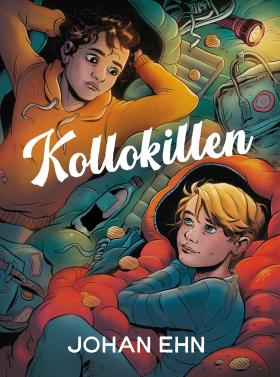
Kollokillen
(12 Days of Summer)
by Johan Ehn
reviewed by Maria Lassén-Seger
The protagonist and narrator of Johan Ehn’s children’s book is a sensitive and artistically gifted boy who doesn’t seek out the company of large crowds, but loves to draw and read on his own. Going to camp for the first time is an experience fraught with worry and excitement. Especially since he is prone to overthink things. Will he make any friends? Will he fit in?
On top of that, Robin carries a secret that keeps eating away at his self-confidence. This spring he made a new friend at school, Hugo. Robin realized his feelings were stronger than friendship, but when he admitted how he felt he was met with fear and rejection. Left hanging, he did not know whether his crush had or would be revealed to others at school. The incident has left him scared and scarred – and going off to camp is one way to escape his worries.
In most of his novels, Ehn explores the themes of coming out and being gay, often during challenging circumstances. In Kollokillen (‘12 Days of Summer’) Ehn, for the first time, writes for and about younger children on the verge of becoming teenagers. His prose is nevertheless as swift and clear as in previous novels. The book is based on a radio novella and the oral medium of the first version has been transformed into a smoothly readable text with a pleasant touch of intense, personal narration.
The subject matter is not in itself new: a crucial summer experience in the life of a young person teetering on the brink of growing up. Nordic children’s literature is filled with intense summer stories, in part because the warm, lush and intensely short Nordic summers provide such a striking break from the otherwise harsh and cold climate. But Ehn manages to bring something new to this familiar setting by handling the theme of first love with such profound tenderness and a deep understanding for how confusing and overwhelming one’s first feelings of love and attraction can be.
The teenagers at camp are typically struggling with finding out who they are, competing for popularity and trying their hardest to appear cool and be admired. The camp leaders keep a close watch on how the youngsters treat each other and fill their days with intensive activities tailored to make them come out of their shells and learn how to treat each other with respect. Clearly, Ehn has done research on what youth summer camps are like today and gives a credible account of the daily activities, such as helping a farmer clear his field of roe deer kids before harvesting, nightly gatherings around the campfire and intense swimming lessons in the sweltering heat.
For Robin it is a new experience to be recognized for his drawing talent and detailed knowledge of nature. But even more so, it is his newfound friendship with slightly older Ludvig, who is nothing like Robin – sporty and popular – but with whom he clicks and feels seen and recognized for who he is. As Robin’s feelings for Ludvig grow increasingly stronger, he must face his fear of rejection and ridicule. It is, however, not very helpful that Ludvig keeps giving him mixed signals.
Although camp participants should treat each other with respect, two boy bullies with whom Robin shares a cabin excel in a hard jargon that includes homophobic ‘jokes’. Whereas Ludvig is self-confident enough to shrug such immature behaviour off, Robin finds it harder. Fed up with the two bullies, Ludvig and Robin play a prank on them during their final night at camp. They are successful in bringing about their revenge, but the incident leaves a rather bad taste in this reader’s mouth. Being scared out of their wits may be what these two knuckleheads deserve, but as a means of building trust and acceptance it is hardly a successful strategy. However, Ehn presumably wants to write an engaging story for his young readers and the rather-too-easily successful prank is part of creating an exciting storyline to match the more contemplative passages. Still, I cannot help but think that the novel would have fared just as well without this revenge fantasy acted out.
The great strength of Ehn’s novel is his finely tuned ability to let his readers follow his protagonist’s train of thought without over-simplifying his worries and self-doubt. Especially, the scenes where Ludvig and Robin have their first, trembling experiences of near-electrical physical closeness and attraction are tenderly and engagingly recounted. Drying each other’s hair out after swimming, huddling close together sharing the same hoody, or simply looking one another straight in the eyes are magical moments for Robin, who longs for closeness and a safe place to be who he is.
The book makes it clear that same-sex love is, at heart, much the same as heterosexual love – apart from the former still being harder to live out due to surrounding prejudice. That is no little feat. Whereas YA novels representing homosexual relationships are increasingly and thankfully common today, it is still rare to read about pre-teen love relations between two boys – especially in a manner that gives an inside perspective on how mind-blowingly lovely it can feel to hold hands with or share a first kiss with someone who does not shy away from you, but fully embraces who you are.

Kollokillen
Lilla Piratförlaget, Stockholm, 2024
256 pages
Foreign rights: Grand Agency
Johan Ehn is an actor, playwright, director and author who debuted in 2017 with Down Under. His second YA novel, Hästpojkarna (‘The Horse Boys’), published in 2019, was nominated for awards including the Nordic Council Children and Young People’s Literature Prize in 2020 and won the Nils Holgersson Plaque.
